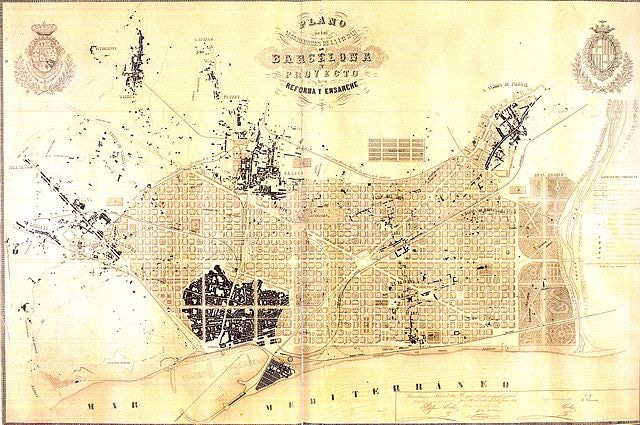Discover the District of L’Eixample in Barcelona
L’Eixample District is called in this way because the engineer and urban planner Ildefons Cerdà decided to widen Barcelona around the old town. The plans to expand the city with a strategy in mind is how this neighborhood emerged, one of the largest in the city. L’Eixample has was planned and built in a practically perfect grid. The characteristic octagonal blocks were a visionary street design for various reasons. The architect broadened the intersections for visibility, taking into account traffic and ventilation, now they are mostly used for short-term parking.

Architecture, museums, restaurants, shops, markets … There is a lot to see and do in this area of Barcelona and today we give you some clues so you can start discovering it.
TABLE OF CONTENTS
What to see and visit in L’Eixample District in Barcelona?
The Paseo de Gracia
One of the arteries of the Barcelona district of L’Eixample is Paseo de Gracia. We recommend that you visit it and contemplate its modernist buildings and the beautiful architecture that we find in it.It also welcomes shops of the most exclusive fashion brands.
Here you will step on the pavement tiles of the avenue, designed by Gaudí, and you will be able to admire the lampposts of Pere Falqués i Urpí. A walk for the enjoyment of your five senses.
Other streets and squares to walk
Continuing our journey through the district of L’Eixample in Barcelona, we recommend you to stroll along the Rambla de Cataluña (the small part, below Diagonal), Diagonal Avenue or the Gran Vía de las Cortes Catalanas. Among the squares that are worth visiting, do not forget Plaza de Cataluña, one of the most popular places in the city due to its location and the swaying of tourists and locals. This area is full of life with gardens and the twin fountains that light up in a 30-minute show on Fridays and Saturdays. We are sure you’ll love it!
The Sagrada Familia
If there is an emblematic building in Barcelona that is the Sagrada Familia of Gaudí. Impressive from the outside and also inside, it is a place with a lot of history whose works are scheduled to end in 2026.
Other emblematic buildings
If you like architecture in the district of L’Eixample in Barcelona, you will be able to see the most important modernist buildings in Barcelona. For example, Casa Batlló by Gaudí and Casa Milà (known as La Pedrera); Casa Amatller, by Josep Puig i Cadafalch, or Casa Fuster and Casa Lleó i Morera, by Lluís Domenech i Montaner.
The neighborhood of Sant Antoni
This neighborhood sits in the district of L’Eixample, and the market of the same name is its most characteristic building. “Mercat Sant Antoni” was built at the end of the 19th century. The Sant Antoni neighborhood hosts cultural events all year long, such as a weekly fair for books and collectibles. Also, it is possible to find the usual fresh produce stands on the market.
Its last restoration has allowed, on the other hand, to reconstruct the frescoes of the walls and a pit was adapted in the basement with a part of a wall recovered from the 17th century.
Fundació Tàpies
The is based in a modernist building by Lluís Domènech i Montaner that was constructed between 1881 and 1885. Its façade combines iron and brick and was the first of its kind to be built in this area of Barcelona.
It is a space starring the life and work of Antoni Tàpies in which exhibitions and cultural activities take place.
To enjoy all this, you have to get to Carrer d’Aragó.
Museu del Modernisme of Barcelona
Following this art route, and since we are in the neighborhood with more modernist buildings in Barcelona, we now offer you a visit to the Museu del Modernisme de Barcelona. Located on Calle Balmes, in this place you can see paintings, sculptures, and furniture in modernist style, as well as temporary exhibitions. It is the only museum specializing in Catalan Modernism throughout the European region.
It is open from Monday to Friday from 10:30 am to 2:00 pm and from 4:00 pm to 7:00 pm. The general entrance, which includes the permanent and temporary exhibition, has a price of 10 euros. On Saturdays, Sundays and holidays the museum is closed.
Mercat dels Encants Vells – Encants Market
It treasures more than 700 years of history and is one of the oldest markets that remain in Europe.
Open every Monday, Wednesday, Friday, and Saturday from 9 a.m. to 8 p.m., the Encants Market of Barcelona has almost 300 shops: clothing, decoration, music, bicycle shops. It also has auction spaces with second-hand products, old and collector’s and, of course, market stalls. You can find a wide selection of gastronomic offers in its bars and restaurants.
You will find it between Avenida Meridiana, Calle Caspe, and Calle Castillejos, in the old Bosquet Dels Encants.
Palau Robert
The Palau Robert is a building located at the intersection of Avenida Diagonal and Paseo de Gracia in the heart of the Eixample district. It was built between 1898 and 1903 to serve as the private residence of Robert Robert i Surís, the Marquis de Robert, a businessman, politician, and aristocrat.
Currently, the building is owned by the Generalitat of Catalonia and has become a cultural center with exhibition halls and concerts, a library and public gardens.
The Palau Robert is also is the headquarters of the Tourism Office of Catalonia, open Monday to Saturday, from 9 a.m. to 8 p.m., Sundays and dresses from 9 a.m. to 2.30 p.m., on January 5, from 9 a.m. to 5 p.m. and on days 24 and 31 of December from 9.00 to 14.30. On December 25 and 26 and January 1 and 6, it closes.
Credits: Aerial view of the Eixample




